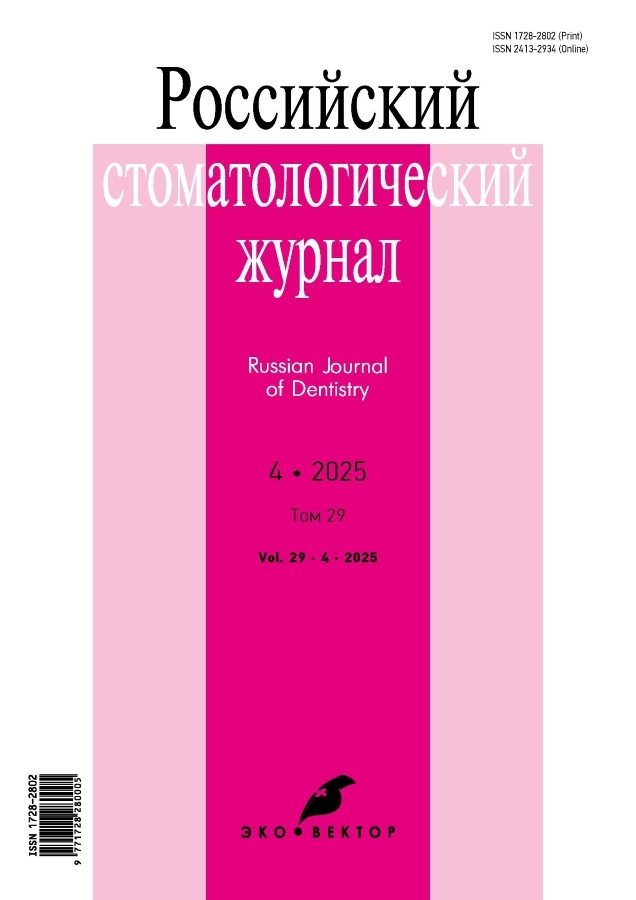Impact of abutment selection on the success of prosthetic rehabilitation in patients with dental implants
- Authors: Kirsanova V.V.1, Furtsev T.V.1
-
Affiliations:
- Professor V.F. Voino-Yasenetsky Krasnoyarsk State Medical University
- Issue: Vol 29, No 4 (2025)
- Pages: 327-333
- Section: Original Study Articles
- Submitted: 16.04.2025
- Accepted: 30.04.2025
- Published: 29.08.2025
- URL: https://rjdentistry.com/1728-2802/article/view/676792
- DOI: https://doi.org/10.17816/dent676792
- EDN: https://elibrary.ru/LFQZCR
- ID: 676792
Cite item
Abstract
BACKGROUND: Dental implantation is one of the most advanced techniques for restoring masticatory function in modern dentistry. However, the use of non-original abutments manufactured by third-party companies remains controversial, particularly regarding their effect on long-term prosthetic outcomes. This study assesses the influence of abutment type—original vs non-original—on peri-implant bone stability.
AIM: This study aimed to evaluate the association between the type of dental prosthetic components—original or non-original—and long-term outcomes of implant-supported prostheses, based on clinical case analysis.
METHODS: A retrospective analysis of panoramic radiographs was performed in patients who received Straumann Bone Level (BL) (Straumann, Switzerland), Nobel Biocare Conical Connection (CC) (Nobel Biocare, USA), or BioHorizons Tapered Internal (BioHorizons, USA) dental implants, with a follow-up period of up to 11 years. Radiographic evaluation included assessment of peri-implant bone levels and the incidence of peri-implantitis.
RESULTS: The χ2 test revealed no statistically significant differences (p > 0.05) between the groups using original and non-original abutments. The analyzed clinical cases confirmed no direct correlation between abutment type and long-term prosthetic success.
CONCLUSION: The abutment type does not significantly influence the success of implant-supported prosthetic treatment. However, it may represent one of multiple factors that collectively contribute to long-term outcomes.
Full Text
About the authors
Viktoriya V. Kirsanova
Professor V.F. Voino-Yasenetsky Krasnoyarsk State Medical University
Email: vikt.kirs@yandex.ru
ORCID iD: 0009-0002-7248-5310
SPIN-code: 1987-4544
Russian Federation, 1 Partizana Zheleznyaka st, Krasnoyarsk, 660022
Taras V. Furtsev
Professor V.F. Voino-Yasenetsky Krasnoyarsk State Medical University
Author for correspondence.
Email: taras.furtsev@gmail.com
ORCID iD: 0000-0002-5300-9274
SPIN-code: 7108-0928
MD, Dr. Sci. (Medicine), Associate Professor
Russian Federation, 1 Partizana Zheleznyaka st, Krasnoyarsk, 660022References
- Ali Z, Baker SR, Shahrbaf S, et al. Oral health-related quality of life after prosthodontic treatment for patients with partial edentulism: A systematic review and meta-analysis. J Prosthet Dent. 2019;121(1):59–68.e3. doi: 10.1016/j.prosdent.2018.03.003 EDN: UQSBTQ
- Aliev AM. Justification for the use of dental implantation in the complex treatment of patients with defects of the dentition (literature review). Molodoj uchenyj. 2016;26:193–196. (In Russ.) EDN: XCHYOT
- Kirsanova VV, Furtsev TV, Lipetskaya EA. Clinical significance of design features of implant systems according to dentists. Cathedra-kafedra. Stomatologicheskoe obrazovanie. 2024;90:52–55. EDN: QDCFKJ
- Kirsanova VV, Furtsev TV, Lukin RS. Clinical significance of design features of implant systems according to dentists. Russian Journal of Dentistry. 2024;28(5):443–451. doi: 10.17816/dent632210 EDN: XDZYNW
- Gorobets SM, Romanenko IG, Dzhereley AA, et al. Risk factors inflammatory complication of dental implantation. Tavricheskiy mediko-biologicheskiy vestnik. (In Russ.) 2017;20(2-1):208–214. EDN: ZEICDH
- Schwarz F, Derks J, Monje A, Wang HL. Peri-implantitis. J Periodontol. 2018;89(Suppl. 1):S267–S290. doi: 10.1002/JPER.16-0350
- Romandini M, Lima C, Pedrinaci I, et al. Prevalence and risk/protective indicators of peri-implant diseases: A university-representative cross-sectional study. Clin Oral Implants Res. 2021;32(1):112–122. doi: 10.1111/clr.13684 EDN: WZPPPT
Supplementary files












